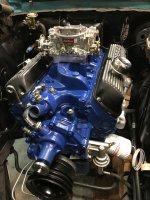robert campbell
Well-known member
- Joined
- Apr 10, 2007
- Messages
- 4,322
Rob
Thanks. You're correct. At idle with vac advance hooked to manifold I get 13* + 15* = 28* which is, BTW, exactly what I would get once I cracked the throttle with the vac advance hooked to ported vacuum. So the only difference is that I already have the advance engaged at idle. And you are spot on in that the engine is much more sensitive to vac fluctuations with manifold when the vac drops below ~14" (above that the vac advance is full on so any fluctuations in the range 14"+ vac has no effect... I checked this using my Mityvac hooked to the vac advance). It is also true that with the large advance at idle the idle screws are only out about 1 turn and the throttle plates are more tightly closed... all making the engine more sensitive to changes to fuel and air vs using ported vac (the upside being better fuel economy and a cooler running engine). To your suggestion about trying ported vac hooked to the advance... to be clear, *I have already tried it* (previous to this current issue) with an increased initial timing of ~15* and, frankly, my engine runs better with manifold vac... that is the main reason I use it. Having said that, I still think that there is some fundamental issue that the engine has always had with a vac leak (not external). With no vac advance at idle and ~12* initial I get 15" of vac with +/-1" flutter... the upside is that that it sounds like I have a more radical cam :wink:. Assuming that the cam is stock (?), I should be getting ~18" vac steady even with 10* idle advance. As the idle advance increases (keeping the RPM the same), the vac goes up and the flutter stops... all consistent with a vac leak. And that is why (I think) my engine seems to "like" manifold vac vac advance... it's covering up/correcting for this internal vac leak.
As usual, thanks for your insight/input. Always appreciated.
James
James,
Cam is a wild card here. Your engine should idle just fine with only 12 to 15 degrees of initial. 28 degrees is way to much at idle.
I have pointed this out before, but as you step on the throttle with "manifold" vacuum to the vac advance, you actually lose advance due to the loss in manifold vac. With ported vacuum when you step on the throttle yes, the vacuum starts to bring in the vac advance, but in a gradual method. Just as the engine demands it and just how the engineers designed the distributor curve to work for basically stock engines.
When you mash the throttle with your setup you actually have an immediate loss in advance of 15 degrees. Amazing that you do not have some sort of a flat spot. With ported vacuum the centrifugal starts to pull in and if you dial in 15 to 16 degrees of initial and use ported vacuum, the engine starts from a better spot.
Hate to say it again, but you need to try 16 degrees of initial, ported vacuum, and readjust your carb to this setting. I am truly convinced it would run a lot better!
What have you got to lose? At 28 degrees of advance at idle I would love to see a dyno pull curve from idle to full throttle. Your engine would fall flat on its face right off the bat and then finally catch up at around 2,500 rpm.
Rob

